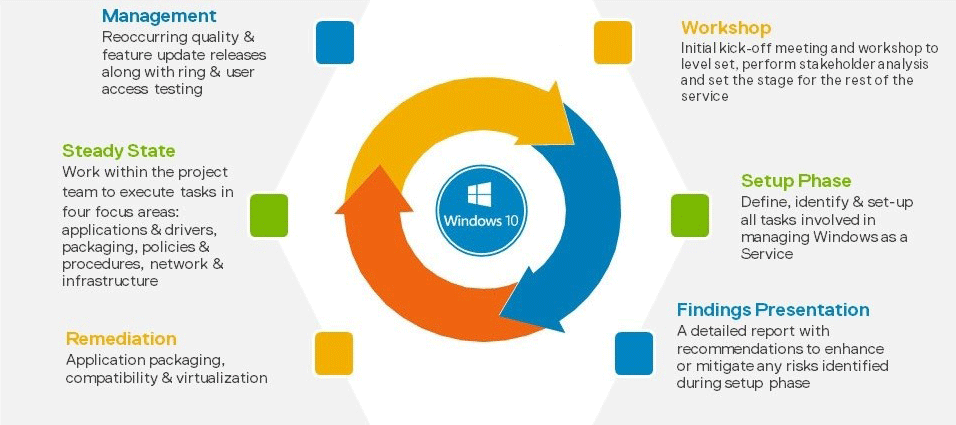With Windows 10, Microsoft Has Changed the PC Operating System Model – What You Need to Know
Is your organization still not fully migrated to Windows 10? You’re not alone. Chances are you have questions (and plenty of them) around Windows 10. As Microsoft’s Windows 10 Deployment Partner of the Year in 2016 and Windows and Devices Deployment Partner of the Year in 2017, we’re proven experts and here to help.

We have found that Windows as a Service (WaaS) is one of the areas where IT departments have the most questions including:
- Is it optional?
- How disruptive is it and will my employees have downtime?
- Will my applications still work?
First, it’s helpful to understand how Microsoft rebooted Windows adoption. For decades Microsoft used a waterfall and major product release approach to Windows. Every three or four years Microsoft would release a new version of Windows, and IT departments around the world would spin up massive migration projects.
That needed to change. In a market that is becoming highly agile, waiting years for updates just isn’t fast enough. So with Windows 10, Microsoft flipped the model on its head. New releases and features update a couple of times per year. That means IT departments need to prepare to continuously deploy Windows updates. It’s not a foreign concept to regular off-the-shelf software or mobile devices, but it’s a big change for Windows PCs.
What’s the upside? No more expensive and disruptive mass Windows migrations every few years. It turns migration into a predictable and continual process. It also means users and IT get important new features faster, and change happens incrementally without the major disruption that big changes like previous Windows versions created.
Finding the Way Forward
This approach also introduces new issues that organizations need to plan for, and means that OS migration will be an ongoing maintenance activity. Every organization needs to plan for WaaS, otherwise your versions of Windows will get hopelessly out of date.
We recommend implementing a change management program that includes:
- Identifying critical applications that need additional testing
- Creating rollout rings
- Designing User Access Testing (UAT) plans
- Establishing Change Management (CM) workflows
- Schedule the activities to coincide with Microsoft branch releases to Insider Preview, Semi-Annual Channel (Targeted), and Semi-Annual Channel.
We have collaborated with Microsoft to introduce a new service to design and manage these processes and alleviate pressure on an organization’s IT team. Our phased approach begins by assessing and creating all of the policies and procedures that will be used to manage WaaS. Then we can help you manage ongoing testing, pilot release and production rollouts.

“We’re excited to work closely with Dell to help deliver a truly modern desktop and laptop computing experience,” said Bernardo Caldas, General Manager, Windows Commercial Marketing. “With this service, Dell is leading the way to help our joint customers deploy their upgrades quickly and seamlessly to minimize any disruption.”
The service is built on Microsoft’s Windows as a Service framework and leverages Dell’s team of global Windows experts. You get a team of consultants that help assess, identify and manage key infrastructure, policy and application processes for managing WaaS. This helps reduce the complexity of application testing for an OS upgrade and establishes a programmatic approach to consume quality and feature updates.
So back to our original questions. Is it optional? (not really) How disruptive is it and will my employees have downtime? (not if you manage it well). Will my applications still work? (yes, with the right preparation). Dell WaaS services can help organizations reduce IT utilization, allowing IT staff to focus on driving core business results. Click here for more information.
This service is one of two new Windows 10 managed service offerings we are debuting this week at Microsoft Inspire, Microsoft’s annual partner conference. The Windows Defender Advanced Threat Protection Managed Service help customers know if they are under attack, by whom, as well as the severity of the attack. Cyber threats are analyzed by our security professionals to detect and investigate a range of attacks, malicious behavior, and provide specific guidance to take action. Learn more from this blog.